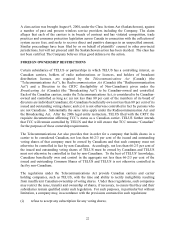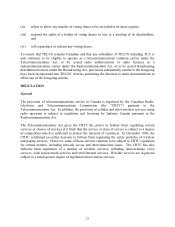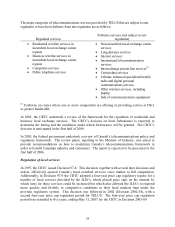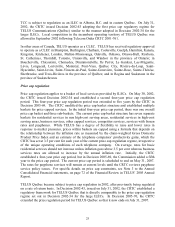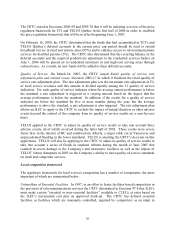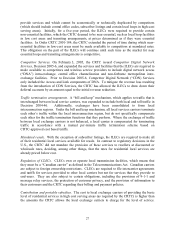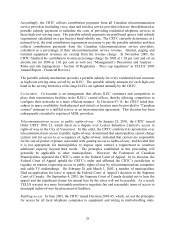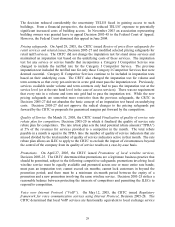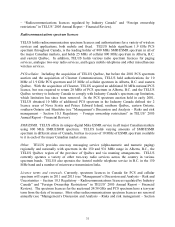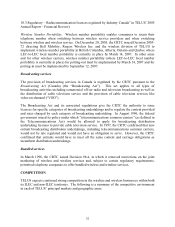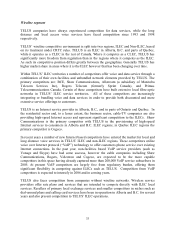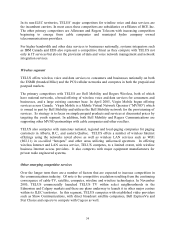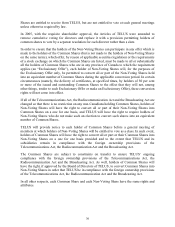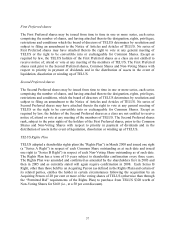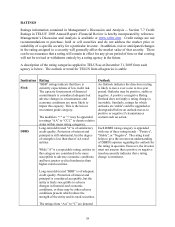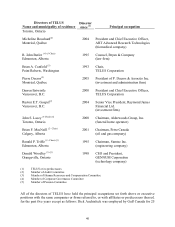Telus 2005 Annual Report Download - page 31
Download and view the complete annual report
Please find page 31 of the 2005 Telus annual report below. You can navigate through the pages in the report by either clicking on the pages listed below, or by using the keyword search tool below to find specific information within the annual report. 30
and that the current regulatory framework governing local competition will apply to local VoIP
service providers. The CRTC determined that ILECs may only provide VoIP services in their
incumbent territories in accordance with approved tariffs.
On July 28, 2005 Aliant Telecom Inc., Bell Canada, Saskatchewan Telecommunications,
Télébec, société en commandite, and TELUS Communications Inc. petitioned the Governor in
Council to intervene and eliminate the economic regulation of VoIP services. In addition, Bell
Canada, Saskatchewan Telecommunications and TELUS have appealed Decision 2005-28 to the
Federal Court to eliminate the application of the winback rule on VoIP services.
Regulation of long distance services
In 1992, the CRTC issued Decision 92-12 which removed most of the restrictions on resale in
the Canadian public long distance voice market and established the terms and conditions for
entry by service providers which own and operate their own transmission facilities. This
decision also established the rules which mandate the provision of equal ease of access to
services of long distance carriers, the protection of competitor confidential information, the
methods for interconnection by long distance carriers and resellers to the local telephone
networks of local exchange carriers and the requirement for the payment of a contribution by
long distance carriers and resellers to local exchange carriers which is used to subsidize the costs
of providing below-cost local telephone services. In Decision 93-17, the CRTC extended the
terms and conditions for long distance competition established in Decision 92-12 to the Alberta
market.
In Decision 97-19, issued in December 1997, the CRTC concluded that the long distance and
toll-free markets were sufficiently competitive to protect the interests of customers, and that it
would be appropriate to forbear from regulation of these services. As a result, TELUS is no
longer required to file and obtain CRTC approval of tariffs specifying rates for such services.
However, TELUS is required to provide the CRTC, and to make publicly available, rate
schedules setting out the rates for North American basic long distance service, and to update
them within 14 days of any change in such rates. In addition, the CRTC has placed a cap on
these schedules so that the weighted average rate for each schedule will not be allowed to
increase. These conditions were reviewed and retained by the CRTC as part of the review of the
price cap regulation regime that applies to TELUS.
Regulation of wireless services
The use of radio spectrum is subject to regulation and licensing by Industry Canada pursuant to
the Radiocommunication Act, which is administered by Industry Canada. All of
TELUS’wireless communications services depend on the use of radio frequencies.
The Minister of Industry has the authority to suspend or revoke radio spectrum licences if the
licence holder has contravened the Radiocommunication Act, regulations or terms and conditions
of its licence and after giving the holder of the licence a reasonable opportunity to make
representations. Licence revocation is rare; licences are usually renewed upon expiration (see
“Management’s Discussion and Analysis – Risks and risk management – Section 10 Regulatory




